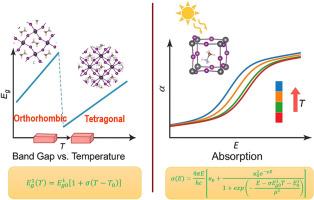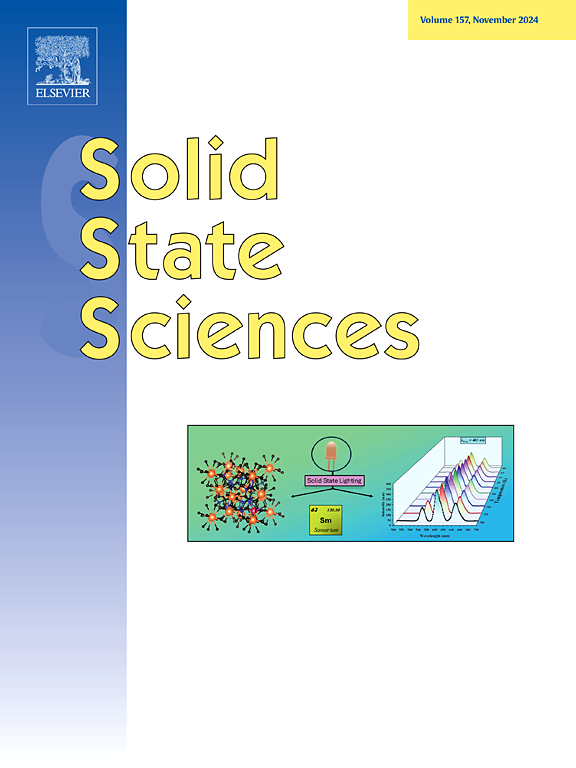热效应对MAPbI3钙钛矿太阳能电池带隙和吸收的影响
IF 3.3
3区 化学
Q2 CHEMISTRY, INORGANIC & NUCLEAR
引用次数: 0
摘要
作为控制半导体光电性能的关键参数,带隙对太阳能电池的性能起着至关重要的作用。在这项研究中,我们研究了甲基碘化铅铵(MAPbI3)钙钛矿的带隙和吸收系数对温度的依赖性。与硅等传统半导体的带隙随温度升高而减小不同,MAPbI3的带隙随温度升高而增大。通过分析钙钛矿和其他具有类似行为的材料的结构特性,我们提出了一个理论框架来解释这种现象。我们将这种行为归因于14族原子的存在,以及它们的s轨道电子的影响。此外,在MAPbI3带隙的温度依赖性中观察到不连续,我们将其与在正交向四方相变期间与I-Pb-I弯曲模式相关的态密度变化联系起来。基于这些发现,我们提出了一个准确描述MAPbI3带隙温度依赖性的理论模型,与实验数据非常吻合。利用该模型,我们进一步推导了吸收系数的温度依赖性,为钙钛矿基太阳能电池的光学特性提供了有价值的见解。本文章由计算机程序翻译,如有差异,请以英文原文为准。

Understanding thermal effects on band gap and absorption in MAPbI3 perovskite solar cells
As a key parameter governing the optoelectronic properties of semiconductors, the band gap plays a crucial role in determining the performance of solar cells. In this study, we investigate the temperature dependence of the band gap and absorption coefficient of methylammonium lead iodide (MAPbI3) perovskite. Unlike conventional semiconductors such as silicon, where the band gap decreases with increasing temperature, MAPbI3 exhibits the opposite trend, with the band gap increasing as the temperature rises. By analyzing the structural properties of perovskites and other materials with similar behavior, we propose a theoretical framework to explain this phenomenon. We attribute this behavior to the presence of group-14 atoms, and the influence of their s-orbital electrons. Furthermore, a discontinuity is observed in the temperature dependence of the MAPbI3 band gap, which we link to changes in the density of states associated with the I–Pb–I bending mode during the orthorhombic-to-tetragonal phase transition. Based on these findings, we present a theoretical model that accurately describes the temperature dependence of the MAPbI3 band gap, showing excellent agreement with experimental data. Using this model, we further derive the temperature dependence of the absorption coefficient, providing valuable insights into the optical properties of perovskite-based solar cells.
求助全文
通过发布文献求助,成功后即可免费获取论文全文。
去求助
来源期刊

Solid State Sciences
化学-无机化学与核化学
CiteScore
6.60
自引率
2.90%
发文量
214
审稿时长
27 days
期刊介绍:
Solid State Sciences is the journal for researchers from the broad solid state chemistry and physics community. It publishes key articles on all aspects of solid state synthesis, structure-property relationships, theory and functionalities, in relation with experiments.
Key topics for stand-alone papers and special issues:
-Novel ways of synthesis, inorganic functional materials, including porous and glassy materials, hybrid organic-inorganic compounds and nanomaterials
-Physical properties, emphasizing but not limited to the electrical, magnetical and optical features
-Materials related to information technology and energy and environmental sciences.
The journal publishes feature articles from experts in the field upon invitation.
Solid State Sciences - your gateway to energy-related materials.
 求助内容:
求助内容: 应助结果提醒方式:
应助结果提醒方式:


